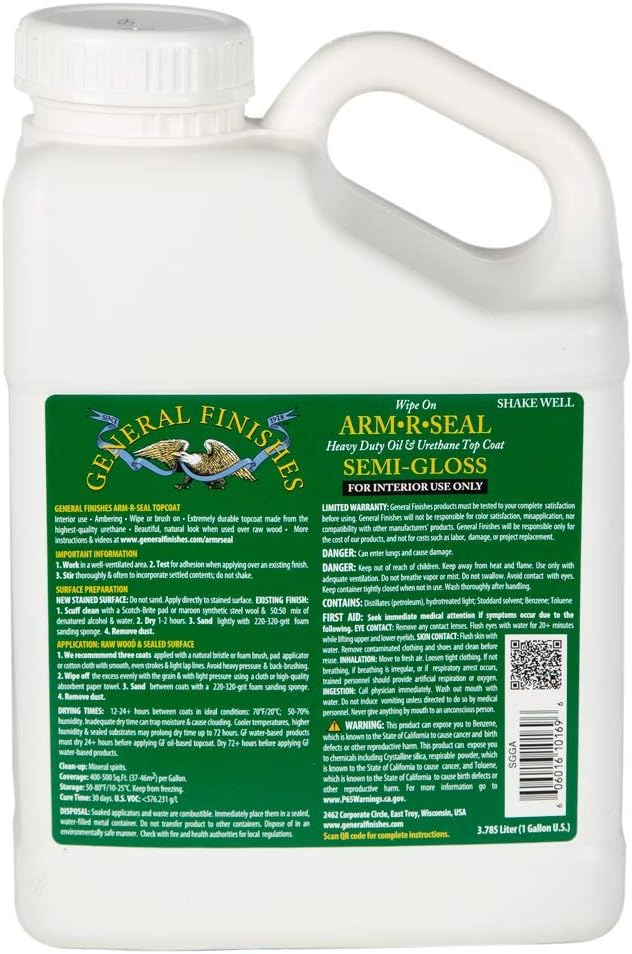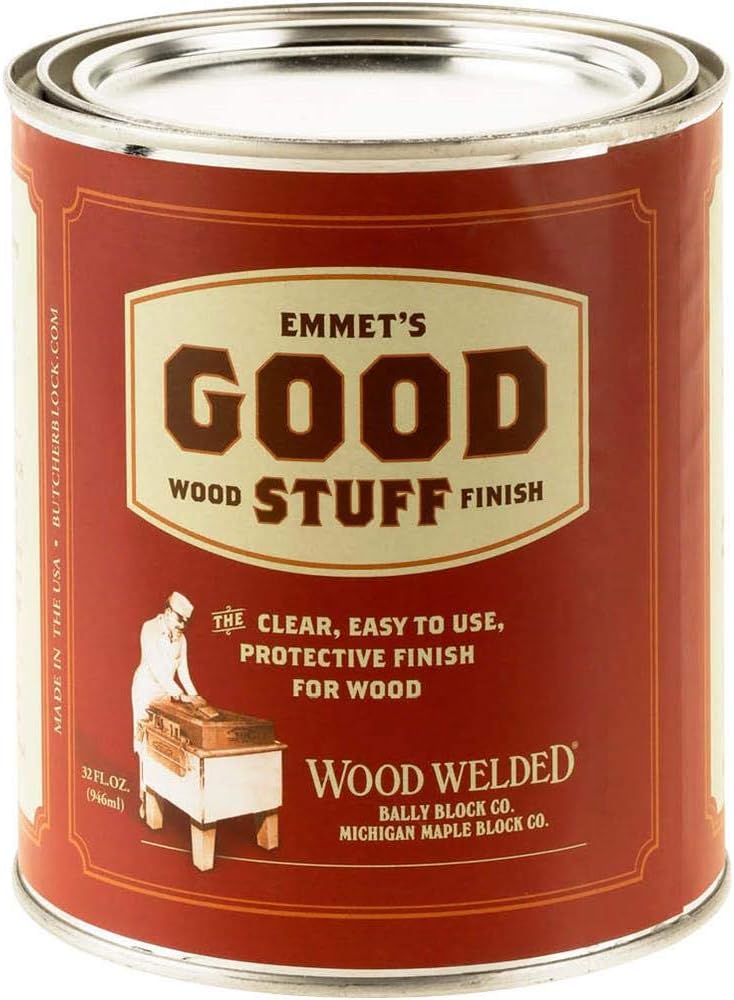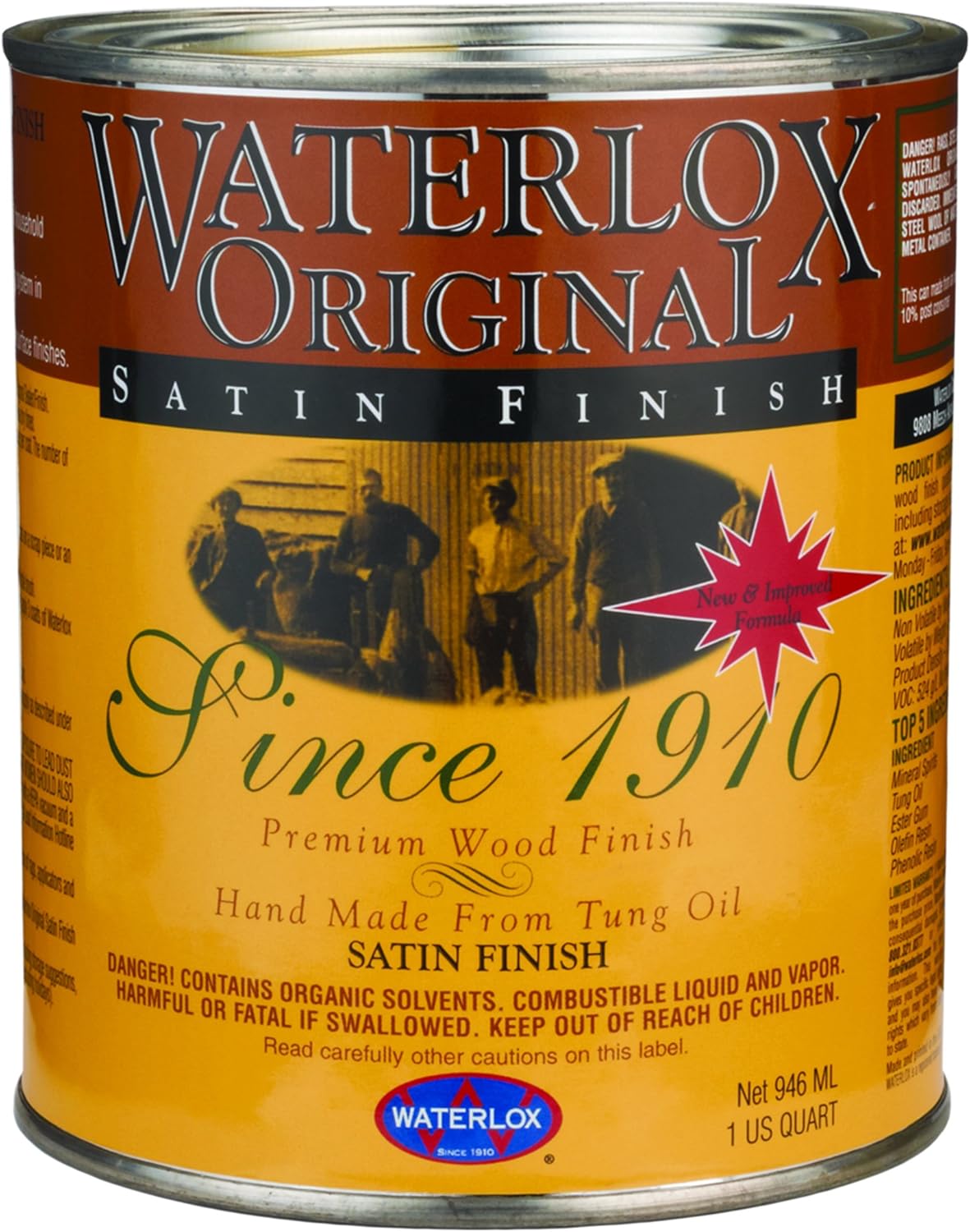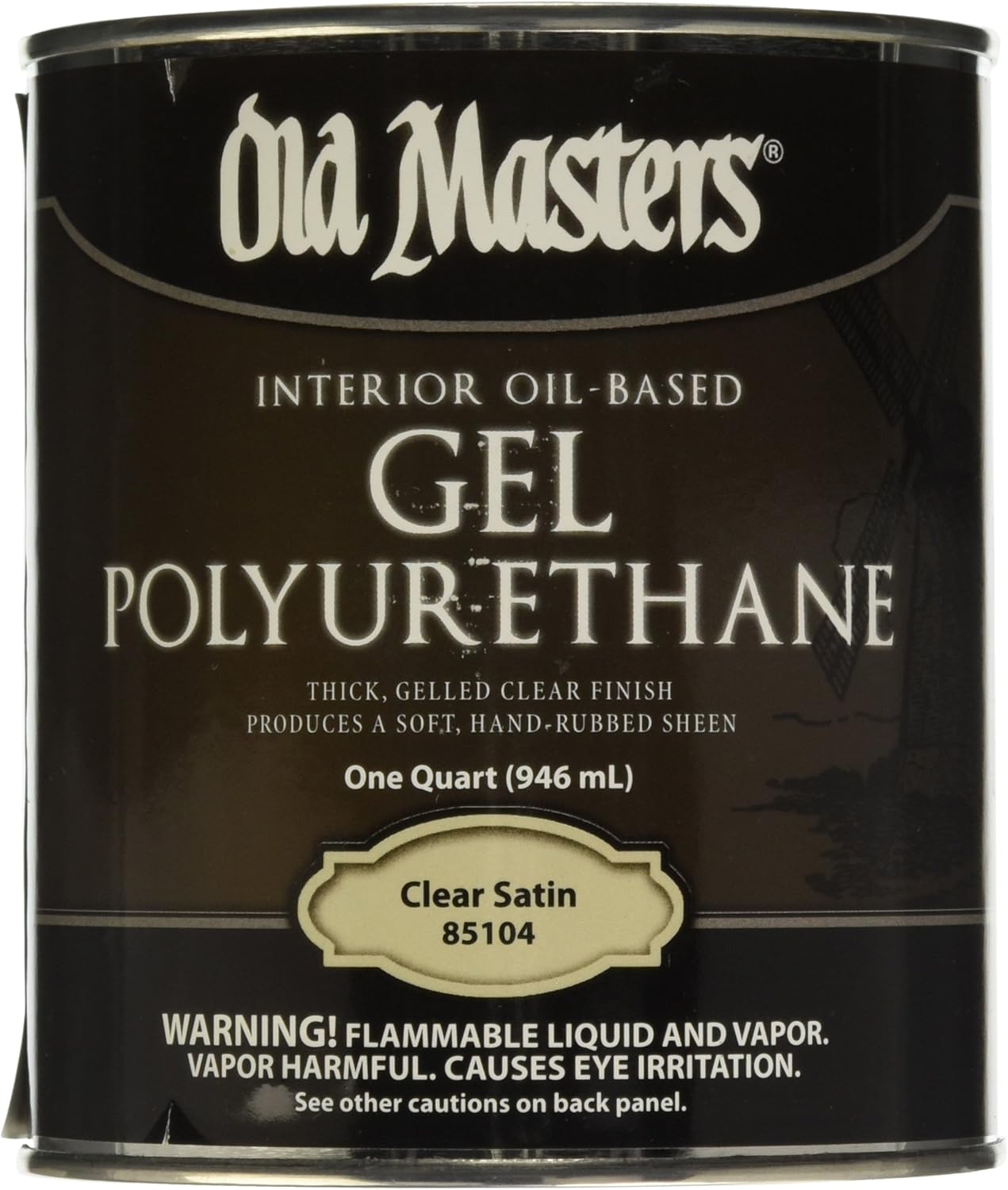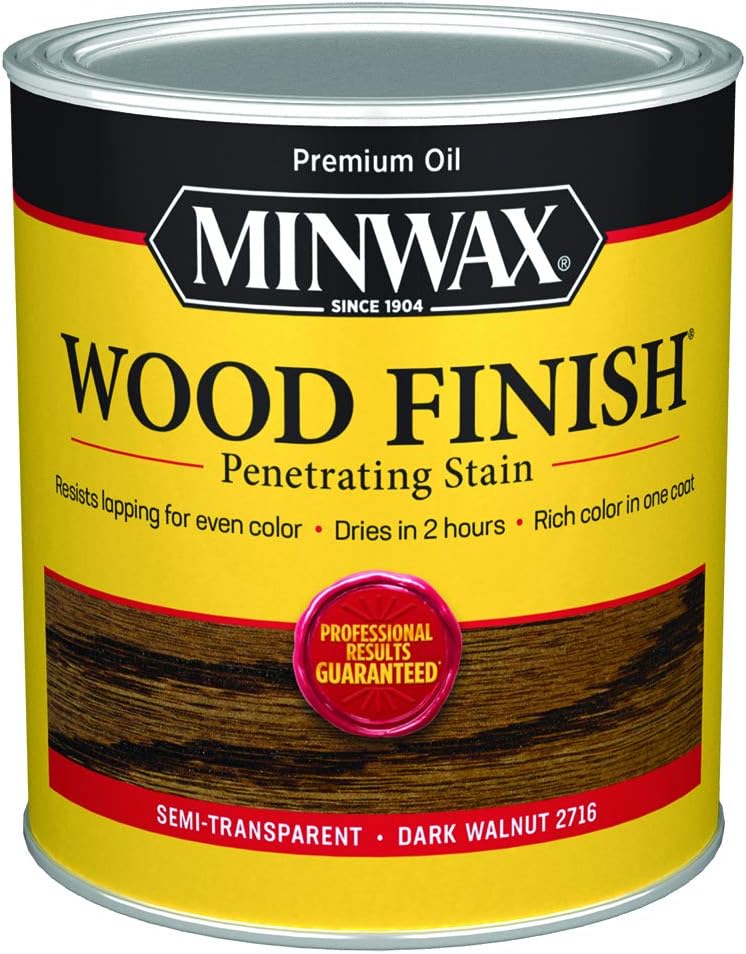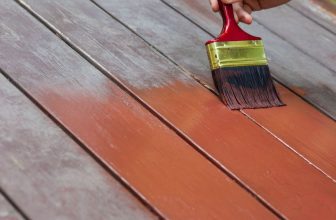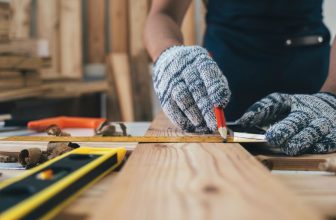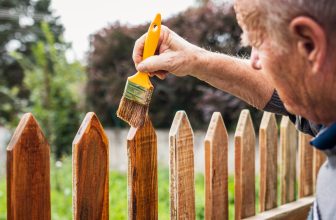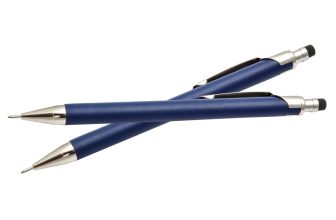Contents
There are few things more rewarding than stepping back from days or weeks of woodworking to see a completed kitchen table for your home. However, before you display your project proudly, you’ll want to finish it to protect it from everyday use and help maintain its natural beauty.
I put together the below reviews and buyer’s guide to help you choose the best possible finish for your table.
Best Finishes for Wood Kitchen Table – Top Picks
BuildEazy.com may earn a commission if you purchase a product through one of our links.
General Finishes is a well-respected brand name in the woodworking industry. They create a variety of finishes, stains, and sealers to help protect wood.
This is an oil-based finish that is relatively thick, so I recommend applying it with a cloth. You could opt for a foam brush for faster coverage, but I found that foam makes it bubble up a bit, requiring sanding between coats. I recommend waiting about 12 hours before recoating to allow for adequate curing.
It provides a very durable topcoat that can stand up to heavy traffic from hands, elbows, cutlery, plates, and glassware. It will likely protect your wood for several years without needing to be refinished.
It offers a waterproof barrier in addition to physical protection, so it will keep your table defended from spills and food stains.
This finish is not food safe, so any food that comes in contact with the treated surface should not be consumed.
It’s available in satin, semi-gloss, and gloss finishes, so you’ll have your choice of sheen and can customize depending on your other furniture and decor.
It comes in pint, quart, and gallon containers, allowing you to optimize your cost for your project’s size. Each size is relatively inexpensive, and it provides excellent value for the money.
This finish has very little smell, so you can plan to use your kitchen table shortly after the last coat has dried. However, it does contain some volatile organic compounds (VOCs), so I recommend wearing a face mask and gloves when using this product.
Minwax 63010444 Fast Drying Polyurethane Clear Finish
Minwax is one of the most recognizable and trusted names in woodworking. They offer stains, finishes, and other wood treatments to accentuate and protect wood’s natural beauty.
This is an oil-based poly. It’s relatively viscous, making it a breeze to apply. I recommend using a clean cloth to rub this on, but a foam brush or a very thick natural bristle brush could work as well.
For tips on getting the cleanest application possible, check out this video:
It dries very quickly, so it’s best to apply this in a dust-free area to avoid mistakes and the need for sanding and touch-ups. Despite the rapid drying time, I strongly recommend allowing this to cure for around 24 hours before reapplying or exposing the surface to wear.
This finish leaves behind robust physical protection, so it will help keep your table safe from scratching and scuffing, even throughout constant use. The polyurethane contained in the solution offers defense against liquids and food stains, so you won’t have to worry about spills or messes that can frequently occur on tables.
This finish is not food-safe, so you’ll need to be careful not to consume any food that comes in contact with it, even after it’s fully cured. The potentially harmful chemicals could leach into your food and present a problem for you or your family.
This finish is available in satin, semi-gloss, and gloss finishes, so you can choose your desired sheen. I recommend a satin or semi-gloss finish for a more natural look on raw wood, like maple.
Minwax offers this polyurethane in one-quart cans that are somewhat expensive compared to other options. However, the protection this finish provides will likely last for several years, so I believe it’s worth the money.
It has a low odor and won’t smell up your kitchen. It contains some volatile organic compounds (VOCs), so it’s best to wear a face mask and gloves when applying.
Grizzly Industrial H2372 Good Stuff Wood Finish for Maple Tops
Grizzly Industrial predominantly manufactures high-quality woodworking tools, but they also offer several wood finishes and treatments for maintaining project durability.
This is a urethane-based finish that is thin, making it very easy to apply with a cloth. I got the best coverage and results when working it onto my projects with a circular motion. You could opt for a foam brush, but I experienced some imperfections when applying with foam.
I recommend waiting at least four hours in between coats to allow curing on the surface. Once it is completely dry, it creates a nice protective layer on your wood that will help resist some minor damage from scratching, scuffing, and regular use. It doesn’t offer the same resistance as many other options, so it’s best for hardwoods that will naturally resist damage.
Just a few coats will also provide protection from water, alcohol, and other food spills, so you won’t have to worry about damaging your hard work once this finish has cured over the top.
Since this product is urethane-based, it is entirely food safe once it has dried. This is an excellent option for those who have children or pets in their home who may decide to eat directly off the table if the opportunity arises.
It only comes in a low-gloss finish, so you’ll have to choose a different product if you’re looking for a high shine. However, the appearance is gorgeous and entirely clear, so it won’t discolor your wood or detract from its natural beauty.
This finish is only available in one-quart cans, and it is costly. However, I think it’s worth the money if you want great protection while remaining safe for food contact.
The formula has a low odor and contains no VOCs. You don’t need protective gear when using this finish, but I recommend gloves just to maintain cleanliness.
Waterlox TB 6044 Original Satin Finish
Waterlox specializes in highly protective wood finishes and sealers that resist physical damage and maintain water resistance.
This is an oil-based finish made primarily from tung oil. It’s somewhat viscous but not quite thick enough to make brush application easy. I recommend applying this with a clean cloth. It tends to bubble a bit while you’re working, but working on a hot day and being sure to make light passes will help limit surface imperfections.
This hardens into a durable layer over your wood, so you can rest assured that your table will be protected from scratching and scuffing from glassware, cutlery, plates, and regular use.
The tung oil contained in the solution creates a water-resistant seal on your table. It will keep the wood underneath safe from water damage and stains from drinks or food served on your table.
This product is not food-safe, so you’ll have to be careful not to consume any food that contacts the surface.
It’s only available in a satin finish. I prefer this low-sheen option, but you’ll have to choose a different product if you want a semi-gloss or glossy appearance.
You can only purchase this product in one-quart cans, making larger tables a bit more challenging to cover correctly. It is relatively expensive, especially given how much you get in one container.
It has a more pungent odor than many other finishes because of the VOC content. I strongly recommend you wear protective gear when using this, including gloves and a face mask. It should only be used outside or in well-ventilated areas.
Varathane 200041H Water-Based Ultimate Polyurethane
Varathane is a prominent brand name in the woodworking industry known for its wood finishes, stains, and protective coatings.
This polyurethane is water-based, which means it’s very thin and can only be applied with a clean cloth or foam brush. I found some bubbles forming when using a foam applicator, so I recommend rubbing this on.
When applied correctly, this finish provides excellent protection for your wood. It will resist scratches and scuffs, so it’s a great option for tabletops that will see a lot of use and wear. However, the low viscosity means it goes on very thin. As such, you’ll need to apply at least three coats to get the same protection as many other products provide in two. This will extend your working time quite a bit.
It dries to the touch very quickly and cures enough for recoating in about two hours, so the time you’ll wait around for it to dry is minimal.
Once it’s dry, it defends against food stains and liquids that are common on kitchen tables.
This product is not food-safe, so you will need to make sure any food that touches the surface isn’t consumed.
It’s available in satin, semi-gloss, and gloss finishes, all of which dry crystal clear and won’t discolor your wood at all. It also won’t cause yellowing over white or light-colored paint, so this is suitable for use on just about any natural wood, paint, or stain.
It’s available in half-pint and one-quart cans. It is relatively expensive, but it offers excellent coverage.
It contains some VOCs and has a reasonably strong odor until it dries. As such, I strongly recommend wearing protective gear when using this product.
Rust-Oleum Varathane 9061H ½-Pint Interior Oil Polyurethane
Rust-Oleum is a respected name for its products designed for priming, painting, and protecting surfaces. Their finishes are used across multiple industries, including woodworking.
This is an oil-based polyurethane that is very thick. It’s not quite thick enough to apply easily with a brush, but it can also be a bit challenging to rub on with a cloth. I recommend opting for the latter.
It dries very quickly to the touch, which means you’ll have minimal time to correct any mistakes. It’s also best to work in a dust-free area, otherwise you’ll have a difficult time with debris landing and drying on the surface.
It cures into a durable protective layer that will resist scratching and other physical damage with ease. It also creates a water-resistant barrier that will stand up to spills and food messes without the risk of ruining the wood below. These protective qualities make it an excellent choice for high-traffic kitchen tables.
This finish is not food-safe, so you’ll need to be careful not to ingest anything that comes in contact with it. As I said in the previous review, you’ll need to be careful not to let your family members or pets eat anything that drops on the table.
It’s only available in a gloss finish, which is too shiny for my liking. You may enjoy the appearance if you’re looking for a high sheen on your table. It will darken your wood a bit, so be prepared for some minor discoloration accented by a shiny finish.
It comes in half-pint cans that make larger jobs challenging. However, they are reasonably priced, so you could purchase multiple containers and still stay within your budget for larger projects.
This product contains VOCs, so the vapor is unsafe to inhale. I strongly recommend using this product outdoors or in well-ventilated areas inside. It’s best to wear gloves and a face mask or respirator while working with this finish.
Old Masters Clear Satin Finish
Old Masters offers many different wood finishes for adding protection and beauty, including waxes, polyurethanes, and sealers.
This is a gel polyurethane, meaning it’s exceptionally thick. You can most easily apply this with a dense natural or synthetic brush, which means you can get the job done quickly. However, it takes longer than most products to cure fully. I recommend waiting about eight hours before recoating and a full three days before exposing your finished tabletop to regular use.
The long curing process does equate to an incredibly durable layer of physical protection. I’m confident this will stand up to years of regular use without wearing down too much. This makes it ideal for tabletops that get used daily.
It forms a water-resistant barrier that will defend against liquids and food stains, protecting your wood from damage that can occur during meals.
This polyurethane is not food-safe, so it can be dangerous to eat food that comes in contact with it. As such, it’s not the best product for homes with children who won’t know not to eat directly off of the table.
It’s only available in clear satin. This happens to be my favorite finish for a natural-looking kitchen table, but you may prefer another option if you like a shine on your furniture.
It comes in one-quart cans that are somewhat expensive. It has a lower coverage than many other options because of the thickness, increasing the effective price even more. However, the viscosity means it can settle and level itself into nooks or imperfections in your wood table, leaving a beautiful, professional-looking finish.
This product contains VOCs, so you’ll want to avoid inhaling the fumes. Application outside is best, and I strongly suggest you wear a face mask or respirator and gloves when using this polyurethane.
General Finishes Enduro-VAR Water Based Urethane Topcoat
This is a water-based polyurethane, but it’s thicker than most others with similar formulas. It’s thin enough for easy cloth application or use with a foam brush, but I recommend rubbing this onto your table. I experienced quite a few bubbles when I used a foam applicator.
It dries quickly but cures slowly and won’t be ready for recoating for about six to eight hours. I found the best results with a light sanding between coats. The dry time and the need for sanding will extend your total project time quite a bit.
Once it’s dry, it adds great protection from scratches, scuffs, and other physical damage. I’m confident this will stand up to regular use for several years without needing to be reapplied.
General Finishes’ products are known for their waterproofing capabilities, and this product is no exception. This stands up exceptionally well to regular exposure to liquids, and it will resist food stains as well.
This is not food-safe, so you’ll have to make sure everyone in your home knows not to eat food that has come in contact with your table.
It’s available in flat, satin, semi-gloss, and gloss finishes, so you’ll have your pick of the sheen you want. The flat finish provides a beautiful, rustic appearance on natural wood, so it’s an excellent option for higher-quality wood like maple or cherry.
This finish comes in one-quart and one-gallon cans, so it’s suitable for small and large projects. However, it is very pricey and may run you over your budget.
This product contains VOCs and is unsafe to use in enclosed spaces. The fumes can be harmful, so I strongly recommend wearing a mask and gloves when using this polyurethane.
Minwax 70012444 Wood Finish Penetrating Stain
This is an oil-based stain, but it doesn’t contain any polyurethane. As such, it’s very thin and easy to apply with a rag. You could use a foam brush, but you’ll get much better coverage and even color if you rub this into the grain. It takes a bit of effort to apply correctly, but the result is good, and the process is straightforward.
The treated surface will be dry to the touch in about two hours, but I recommend waiting six to eight hours before recoating if needed. The color darkens slightly as it dries fully, so applying a second coat too quickly may end up in your table being darker than you anticipate.
This doesn’t contain any hardening materials, so it won’t provide any physical protection. However, the stain will help your wood remain rich in color even if it’s exposed to the sun, so you’ll have the benefit of some minor UV resistance.
The oil is naturally water-resistant, but the protection doesn’t last long beyond the drying period. I recommend using a polyurethane over this stain to add protection from water, moisture, and physical wear that are likely to be an issue on a kitchen table.
This product is not food safe, so you should avoid eating any food that comes in contact with the surface. You can opt to cover this stain with a food-safe protective clear coat, in which case your table surface could be safe for food contact.
This stain is available in 28 different colors, all of which offer good coverage, a beautiful appearance, and a clear view of the wood’s natural grain through the coloration.
To get an idea of how dark the dark walnut stain color is, check out this video:
It comes in one-quart cans only, which are moderately priced. You can get excellent coverage from a single can, making this effectively one of the most affordable finishes. However, the lack of protection it provides may require the use of another coating that can keep your wood safe from scratches, food stains, and water damage.
This stain has a strong odor due to the relatively high concentration of volatile organic compounds (VOCs). As such, I strongly recommend wearing a mask and applying this outdoors or in a heavily ventilated room inside. It readily stains skin and is challenging to clean off your hands, so I also recommend gloves during the staining process.
Tried & True Varnish Oil
Tried & True manufactures several different finishes for wood, all of which focus on both protection and a non-toxic formula that is safe for humans and the environment.
This is an all-natural, oil-based protective coating. It’s far thicker than most other options, which can make it a bit of a challenge to apply. You’ll have to put some effort into rubbing it onto the grain evenly.
For tips on applying this finish, check out this video:
It takes quite a while to dry, and three to four coats are recommended. As such, your entire project will take several days to finish. Additionally, you’ll need to spend some time wiping off any excess product an hour after application, which extends your working time quite a bit.
It offers minimal protection from scratches and scuffs, so it’s best for hardwoods that will naturally resist damage better than softer surfaces.
The oils are naturally water-resistant, so your surface will be somewhat protected from water and moisture. The layer isn’t as durable as many other finishes, so re-application will be needed more often with this product.
The most significant benefit of using this finish is that it’s made of natural oils and resins, making it entirely food-safe, non-toxic, and environmentally friendly. You can use this on your kitchen table without having to worry about disposing of food that comes in contact with the surface.
It’s only available in a semi-gloss finish, but it looks beautiful on a kitchen table. It makes the grain pop and brings out the color of the wood wonderfully.
This finish is available in pints, quarts, and gallons, so it’s suitable for small and large projects. It is relatively expensive, but the additional price may be worth it if you’re looking for a safe alternative to other products.
This product contains no VOCs and has very minimal odor. You can apply this without any safety equipment, and it can be used indoors without ventilation.
Rust-Oleum 260165 Ultimate Polyurethane
This is a water-based acrylic polyurethane, making it thin and very easy to apply with a dense brush, a foam brush, or a rag. I recommend a synthetic bristle brush for the best coverage and protection.
It takes about 15 minutes before it’s dry to the touch but shouldn’t be recoated for around two hours, as the surface can show imperfections if it isn’t entirely cured before being treated again.
This product contains acrylic, which hardens on top of your kitchen table and provides excellent physical protection. It will help your wood resist scratches, scuffs, and other damage, and it’s likely to provide that defense for quite a long time without having to be touched up.
The barrier it creates is also water-resistant, so your table will be safe from water, food spills, and moisture in your kitchen.
This product contains potentially harmful chemicals, so it isn’t food-safe. As such, you should take care not to allow anyone to eat food that has touched the table. This may not be the best option for you if you have children or pets in your home, as they may accidentally eat off of the finished surface.
It’s only available in a matte finish, so it’s not suitable if you’re looking for any kind of sheen.
It’s available in one-quart cans and has decent coverage, so you can use this on small or medium-sized projects without having to purchase multiple containers. It’s reasonably priced, especially given the protection it provides.
This coating has a powerful odor, so I strongly suggest only using this outdoors. Even well-ventilated workshops may not be suitable to get the smell to dissipate quickly. It contains VOCs, so you’ll need a mask and other protective gear when applying it.
Buyer’s Guide
Make sure to consider the below factors when choosing a finish for your kitchen table, as these will affect the ease of application and the protection they provide.
Why You Should Use Finish
Wood finishing is a pretty common practice, but some woodworkers enjoy their projects’ natural appearance and wonder if a finish is necessary. The most significant benefit you’ll see from using a clear coating will be the protection.
Your kitchen table will likely be used every single day. It will be exposed to plates, bowls, silverware, and glasses being shuffled around the surface. You and your family members will touch it frequently with hands and elbows. The kitchen is also prone to food and water spills that can stain or damage unfinished wood, and it can be exposed to regular sunlight.
With the right finish, the hours or days of hard work you put into making your kitchen table will be protected from damages common in the kitchen. They can create a durable barrier that will resist scratches, scuffs, dents, water, moisture, and food. Some can even help resist fading in response to UV damage from the sun.
In addition to the protection, a lovely wood finish can also leave a beautiful shine on the surface of your work. Many coatings are available in various finish options, so you can choose how natural or professional you want your project to appear in your kitchen.
Check out the video below for some tips on choosing the right finish for your project:
2 Categories of Wood Finishes: Surface Finish and Penetrating Finish
Generally speaking, you can use two types of wood finishes to coat your kitchen table: surface finishes and penetrating finishes.
Surface finishes include many water-based formulas that sit on top of your project rather than soaking in between the grain. These typically provide the best physical protection, as they take the damage from scratches and scuffs rather than your wood.
Penetrating finishes include most stains and some natural, oil-based products. These finishes soak into the wood grain and provide protection from underneath the surface. They typically offer excellent defense against water and moisture, but they lack the physical protection you’d get from a surface treatment.
Types of Wood Finishes
There are a variety of finishes you can use for your kitchen table, each with its pros and cons. While some products contain just one of the below options, many contain a mixture of two or more to create the best formula to protect your wood.
Wax
Wood waxes are often made of beeswax or carnauba wax. These are solid at room temperature, making them impractical to use by themselves. They’re most often mixed with other finishes to make application easier.
Waxes harden on the surface, creating some minor physical protection and water resistance. However, you’ll need to reapply them regularly to maintain that layer of defense.
Waxes by themselves are food-safe.
Epoxy
Epoxy is a polymer, meaning it hardens into a durable, plastic-like film over the treated surface. It provides excellent physical protection and water resistance.
However, epoxy is not always food-safe, so it’s not ideal for kitchen tables in homes where children or pets may eat off of the treated surface.
Polyurethane
Polyurethane is one of the more popular protective finishes. It’s very straightforward to apply and get a smooth coat without imperfections.
It hardens as it cures and provides adequate protection from scratches and scuffs. It will resist water and moisture, and it can add a nice sheen to your project without buffing.
Polyurethane is not food-safe. However, some urethanes – like the Grizzly Industrial H2372 Good Stuff Wood Finish for Maple Tops – are food safe once cured.
Oil-Based Finishes
Oil-based finishes can include various oils designed to soak into the wood grain and provide protection from within your project. They don’t resist scratching and scuffing as well as most other options, but they are naturally water-resistant and can protect against spills and moisture common in the kitchen.
Oil-based finishes can be natural or synthetic, so only some are food-safe.
Water-Based Finishes
Water-based finishes don’t soak readily into your wood and instead cure and harden on the surface. As such, they generally provide better physical protection than oil-based options.
Depending on what constituents they’re mixed with, they can provide water-resistance and physical protection. They are usually easy to apply with a bristle or foam brush.
Dye
Wood dye usually comes in powder form that you mix with alcohol solvents or water to make application easy.
These don’t offer any protection on their own, but you can use them to get a variety of natural and unnatural wood colors for more vibrant furniture in your home.
Varnish
Varnish is usually a mixture of oil, resin, and some type of solvent to make application easier. There are many different combinations of these three ingredients, and the ratios will affect the product’s protective qualities.
Varnishes aren’t food-safe, and they often contain VOCs.
Shellac
Shellac is made of a natural resin mixed with an alcohol solvent to make the application straightforward.
It provides some physical protection but really shines in its ability to defend against water. It’s regularly used for outdoor projects, so it’s suitable for kitchen tables where spills are common.
Lacquer
Lacquer is a mixture of resins, solvents, and other protective materials. It hardens on the surface of your project and has excellent protective abilities against physical wear and water.
Lacquer often contains a high concentration of VOCs and has a strong odor.
Stain
Stain contains oil or water as a base and has pigments that interact with your wood surface and leave an intensely colored product. They come in a wide variety of colors and hues.
They don’t add any physical protection and are used strictly for aesthetic purposes. Many woodworkers apply a protective clear coat over the stain.
Stains contain VOCs and are not food-safe.
Features to Take Into Account
The below features can significantly impact the ease of use and the protective qualities of the finish you choose, so pay close attention to them when deciding which product is right for you.
Aesthetics
Your kitchen table will likely be the largest piece of furniture in your home and the focal point of one of your most frequented rooms. As such, the appearance of your table is of utmost importance.
Carefully consider if a product you’re looking to purchase will change the color or shade of your wood project. If you want only to highlight the natural beauty of raw wood, something like a stain won’t be suitable. An entirely clear coat that brings out the grain will likely be best for your purposes.
The sheen of a product is also important for the appearance of your finished piece. Not all products come in multiple finish options, so be sure to select one with the sheen you desire. A matte or satin finish can provide a slightly rustic and natural look, while semi-gloss and gloss look more manufactured or professionally finished.
Durability
You’ll use your kitchen table daily, subjecting it to wear from hands, elbows, glasses, dishes, and silverware. As such, a finish that protects your wood from scratches and scuffs can be very beneficial and can keep your hard work looking beautiful for longer. The durability of a finish will determine how well protected your project is and how often you’ll have to spend time reapplying the finish.
Many options also include protection from water and moisture, another important feature on a kitchen table that is often exposed to spills. Some more natural oils or waxes will wear away more rapidly when exposed to liquids, whereas polyurethane and harder products can last years, even with regular water exposure.
Ease of Use
Some finishes are more challenging to apply than others and can make using them difficult or strenuous. Thicker formulas that contain a high concentration of waxes or resins tend to take more work to massage them over your table. Thin water-based and oil-based finishes can usually be applied with a brush, making the process effortless.
Additionally, some finishes bubble up or tend to leave imperfections on the surface while you work. Suppose you’re a beginner or just want the most comfortable process possible. In that case, it’s best to choose a finish that goes on smoothly, has excellent coverage, and can be brushed on for the least amount of effort during the application.
You may also want to consider the drying time of the finish you select. One that is slow-drying may require some inconvenient waiting between coats, but a finish that dries rapidly won’t give you much time to correct mistakes or imperfections. As such, a longer drying time may be best for beginners.
Price
Every project has a budget, and you’ll want to make sure your finish fits into yours. Some products may appear cheaper than others, but you should consider the size of the can it comes in as well as the coverage it provides.
A particular finish could be twice the price of another, but if it offers better coverage, is more straightforward to apply, and guarantees better protection for your table, it may be worth the additional cost.
Smell and VOCs
Many wood finishes have a strong odor due to their high VOC concentration. Volatile organic compounds are unsafe to inhale, so you should only use products that contain them in well-ventilated areas. You’ll also need to wear a face mask and other protective gear when applying a high-VOC finish.
Higher concentrations of these compounds often mean the product will provide better protection and durability. It’s best to balance the VOC content with the defense you want from your finish.
Type of Wood
The type of wood you make your kitchen table out of can help determine which finish is best. Softwoods like pine usually don’t have the beauty of hardwoods and look best with a stain or a clear coat that darkens the appearance. They also don’t resist damage well, so they’re best treated with a highly protective coating that can prevent scratching and denting.
Most woodworkers opt to highlight the natural beauty of hardwoods rather than staining or coloring them. If you’re working with maple or cherry, I’d recommend an entirely clear coat that will just make the grain pattern pop. Physical protection in a finish is still useful on hardwood tables, but you can get away with less protection since the wood naturally resists damage.
Be Careful! Some Finishes Aren’t Food-Safe
You and your family will be eating at your kitchen table regularly, so you’ll want to be cognizant of whether or not the finish you’re considering is food-safe.
Many of the most protective coatings are not, so you’ll want to avoid eating anything that comes in contact with them.
A food-safe finish may be best for your kitchen table if you have children or pets who may eat off the table without realizing the potential danger of doing so.
Frequently Asked Questions
How Many Coats Of Polyurethane Should You Put On A Kitchen Table
Polyurethane is a synthetic resin that has various forms. In liquid form, it can be used as a varnish or paint, and it can form a lovely finish on wood, latex, or acrylic surfaces. You can purchase it in oil-based, and water-based formulas.
It can also be used in a rigid form and used as a sealant for multiple areas in your home.
Before coating your kitchen table with polyurethane, you must ensure your table has a smooth surface.
You can do this by sanding it down with sandpaper. This will remove any dirt on the table and will make the surface super smooth, ready for coating.
Your table will need at least three coats, but if you’d like a glossier finish, then you can add more. There are two methods for doing this.
You can spray coat it, which will give it more of a furnished look, as the spray will spread the product evenly. You must leave each layer to dry for around 3 hours, and then sand them down well.
If you or anyone in your home has a breathing problem, then using spray to coat the table should be avoided.
The other method you can use is a brush coating method. You must make sure to brush the polyurethane evenly throughout the table, and each coat should be left to dry for at least 2 hours.
After you’ve completed the final coat, leave it to dry for 24 hours and your table should have the perfect finish!
How Do You Seal A Wooden Kitchen Table
Sealing a wooden table can extend its life for many years. You can seal your wooden kitchen table by using finishing oil. Oil finishes work well for tables because they are resistant to water, heat, and food acid. As well as this, they are also hard wearing.
Unlike varnishes, that sit on top of the wood, oils will seep through the wood, but will also darken them, so this is something to bear in mind.
You can purchase some oils that will not change the color of your wood, so if you’d like to keep the original color of the wood, then this is a better option.
The first step will be to prepare your kitchen table, you should do this by sanding it down with sandpaper. Then, you should shake the tin of finishing oil to disperse the ingredients, before pouring it into a tin of your choice.
You should then use a natural cotton brush, or a lint-free cloth, to spread the oil over the table. You should do this using a thin coat, and follow the direction of the wood grain.
Let the oil seep into the wood for around 10 minutes, and then wipe any excess oil away with a cloth. Each coat needs around 5 hours to fully dry, and you’ll need at least 3 coats.
How Do You Waterproof A Wooden Table Top
The table-top of your wooden table is a particularly vulnerable part of this piece of furniture. You can make your tabletop water-resistant by sealing it with certain products.
Oil-based polyurethane varnishes can form a transparent film on wooden surfaces and will protect them from moisture as well as any other wear and tear.
Tung oil is also often used to finish wooden table-tops. The benefit of using this is it adds warmth to the wood, while not becoming darker as time goes on.
If you’d like to make your table water-resistant, then you should add around 6 coats of tung oil.
Carnuba wax can be rubbed onto a tabletop in a paste form. This will combine with the base varnish on the table, and is useful in blocking moisture from spills.
Is Varnish Good For Kitchen Table?
Varnish is frequently used as a generic term for any kind of finish, but traditional varnishes are an older type of finish, and they are made with alkyd resin, solvents, and oils.
When the varnish is added to wooden furniture, it will form a glossy finish. It is particularly good for outdoor furniture, as it has solid content and is water-resistant.
It is a favorite among those who work closely with wood, as it is hardy and gives off a nice glossy tone.
This makes it a good choice for applying to your kitchen table, especially as it is water-resistant.
However, you must ensure it is has been applied correctly, and dried completely, as it can crack, peel, or create bubbles that can lead to damage to the wood.
For the best results, apply the varnish in several layers, with a natural-bristle brush. You must then let it dry for at least 6 hours, to achieve the best finish for your kitchen table.
Final Thoughts
There are various ways you can protect your wooden kitchen table, so it can be part of your household for many years.
Many tables can be purchased with a finish already applied, but if you’d like to save some pennies and do it yourself, then it is completely possible to do and quite simple.
Ensuring your table has a solid finish, will not only give it a shiny, glossy look, it will also protect it from spills, and any other wear and tears.
Conclusion: Which Finish is Best for a Wood Kitchen Table?
Finishing your kitchen table can leave it looking beautiful and professionally-made, and it can add a durable layer of protection from water and physical damage. Not all finishes are equal in their appearance and protective qualities, so no single finish will be best for all applications.
My favorite finish for kitchen tables is the General Finishes Arm-R-Seal Oil Based Topcoat. It’s a breeze to apply without getting surface imperfections, and it provides excellent protection against scratches, scuffs, food spills, and water. It isn’t food-safe, but it has a relatively low concentration of VOCs.

